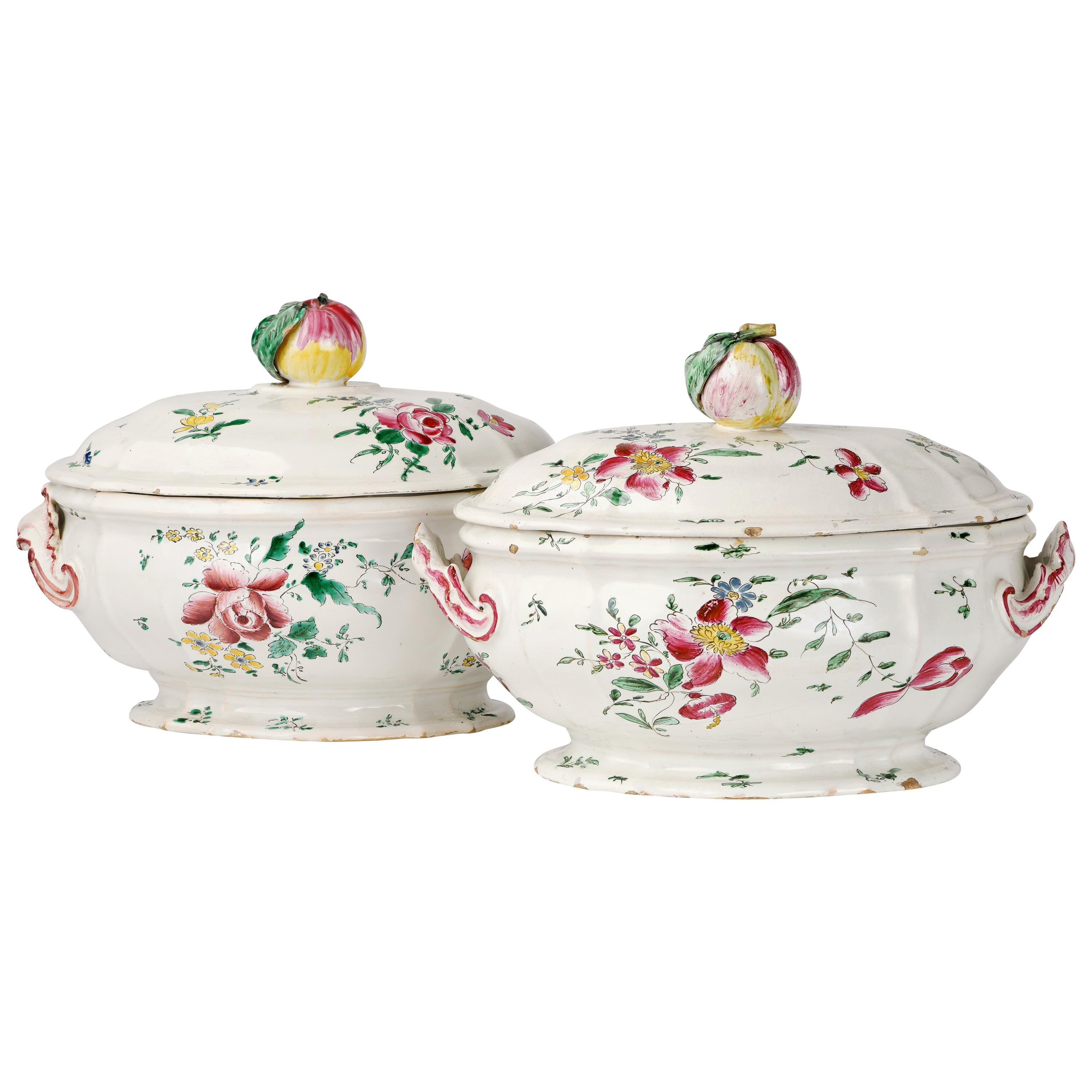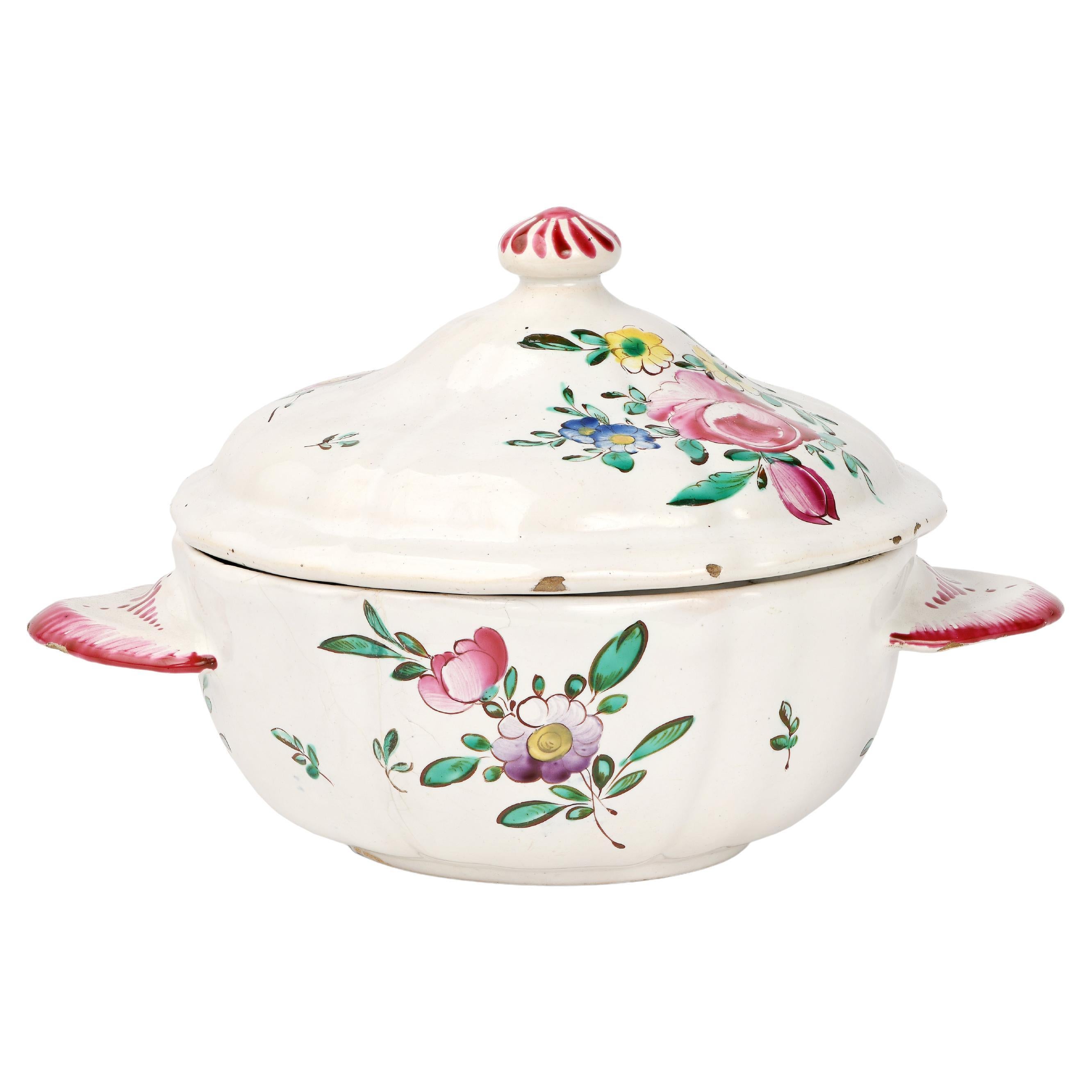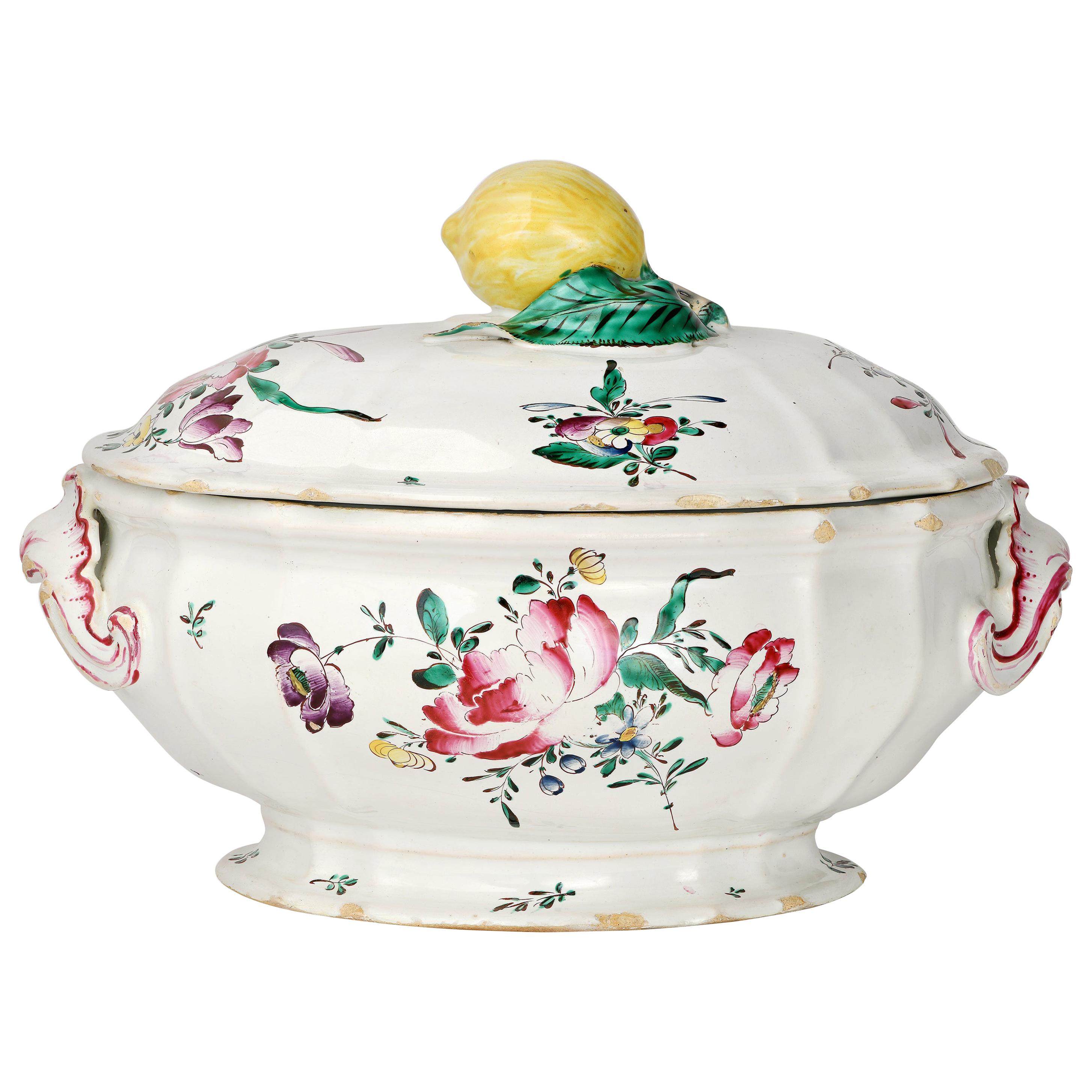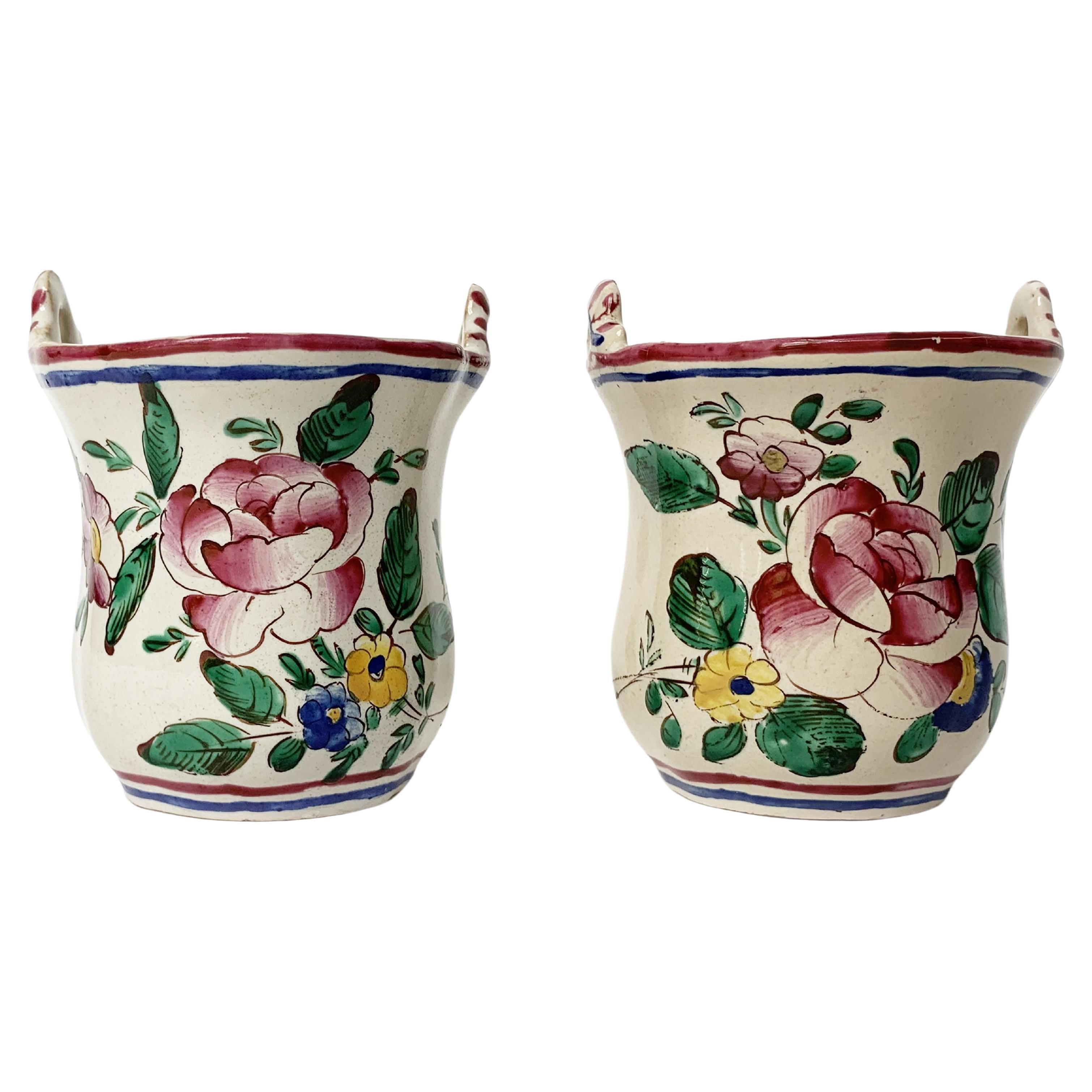Items Similar to Two Pairs of Italian Maiolica Baskets, circa 1780
Video Loading
Want more images or videos?
Request additional images or videos from the seller
1 of 20
Two Pairs of Italian Maiolica Baskets, circa 1780
About the Item
Two pairs of maiolica baskets
Antonio Ferretti Manufacture
Lodi, circa 1770-1790
Maiolica polychrome decorated “a piccolo fuoco” (third fire).
Measures: A) Height 3.54 x 6.69 x 9.84 in (9 x 17 x 25 cm);
B) Height 3.93 x 7.48 x 11.02 in (10 x 19 x 28 cm).
Total weight 4.85 lb (2.200 kg)
State of conservation:
A) One of the smaller baskets has some areas of restoration, the other slight chipping from use;
B) One of the larger baskets is intact and the other shows a clearly glued break.
The mold with which the baskets were forged simulates a wicker weave.
The two larger works have high, vertical walls, with branch-shaped handles penetrating the weave. The painted decorations, small polychrome flowers applied only externally, highlight the points where the weaves intersect.
The decision to leave the center of the basket devoid of decoration is highly unusual, but given the size and complexity of the shape, as well as the quality of the enamel, it is possible to hypothesize that it represents a precise choice in manufacturing or for a particular client.
The two smaller baskets have small, twisted handles and, on the outside, reproduce more decisively the characteristic wicker weave, obtained through thin molded lines. The interior exhibits a rich, typical decoration of naturalistic flowers: a bunch centered around a main flower and secondary stems accompanied by small “semis”. The exterior of these works is also adorned with small little flowers where the weaves intersect.
The size and morphological characteristics of the baskets confirm their attribution to the Lodi factory of Antonio Ferretti between 1770 and 1790, during its most successful period; by this point his original reworking of the "Strasbourg" decoration, known as "old Lodi", had achieved great fame even outside Italy.
This decorative choice represented a strong point of the Lodi factory, which established itself thanks to the vivid nature of the colors made possible by the introduction of a new technique perfected by Paul Hannong in Strasbourg and which Antonio Ferretti introduced in Italy. This production process, called “piccolo fuoco” (third fire), allowed the use of a greater number of colors than in the past; in particular, the purple of Cassius, a red made from gold chloride, was introduced. Its use allowed for many more tones and shades, from pink to purple.
The Ferretti family had started their maiolica manufacturing business in Lodi in 1725.
The forefather Simpliciano had started the business by purchasing an ancient furnace in 1725 and, indeed, we have evidence of the full activity of the furnaces from April of the same year (Novasconi-Ferrari-Corvi, 1964, p. 26 n. 4). Simpliciano had started a production of excellence also thanks to the ownership of clay quarries in Stradella, not far from Pavia. The production was so successful that in 1726 a decree of the Turin Chamber came to prohibit the importation of foreign ceramics, especially from Lodi, to protect internal production (G. Lise, La ceramica a Lodi, Lodi 1981, p. 59).
In its initial stages, the manufacture produced maolicas painted with the “a gran fuoco” (double fire) technique, often in turquoise monochrome, with ornamentation derived from compositional modules in vogue in Rouen in France. This was also thanks to the collaboration of painters like Giorgio Giacinto Rossetti, who placed his name on the best specimens next to the initials of the factory.
In 1748 Simpliciano made his will (Gelmini, 1995, p. 30) appointing his son Giuseppe Antonio (known as Antonio) as universal heir. After 1750, when Simpliciano passed away, Antonio was directly involved in the maiolica factory, increasing its fortunes and achieving a reputation on a European level. Particularly important was the aforementioned introduction in 1760 of the innovative “a piccolo fuoco” (third fire) processing, which, expanding the ornamental repertoire with Saxon-inspired floral themes, could commercially compete with the German porcelains that had one of its most renowned offerings in the naturalistic Deutsche Blumen. Antonio Ferretti understood and promoted this technique and this decoration, proposing it in a fresher and more corrective version, less linked to botanical tables, both with or without contour line, as well as in purple or green monochrome. After efforts to introduce more industrial production techniques to the sector succeeded, even the Ferretti manufacture, in the last decade of the eighteenth century, started heading towards decline despite its attempts to adapt production to neoclassical tastes.
In 1796 the Napoleonic battle for the conquest of the Lodi bridge over the Adda definitively compromised the furnaces. Production resumed, albeit in a rather stunted manner, until Antonio's death on 29 December 1810. (M. L. Gelmini, pp. 28-30, 38, 43 sgg., 130-136 (for Simpliciano); pp. 31 sgg., 45-47, 142-192 (for Antonio).
Similar specimens can be found in the main Lombard public and private collections: a tureen of the same model is kept in Lodi, in the collections of the Civic Museum (Maioliche di Lodi, Milano e Pavia (catal.), Milano 1964, n. 127).
Bibliography for comparison:
C. Baroni, Storia delle ceramiche nel Lodigiano, in Archivio storico per la città e i comuni del circondario e della diocesi di Lodi, XXXIV (1915), pp. 118, 124, 142; XXXV (1916), pp. 5-8;
C. Baroni, La maiolica antica di Lodi, in Archivio storico lombardo, LVIII (1931), pp. 453-455;
L. Ciboldi, La maiolica lodigiana, in Archivio storico lodigiano, LXXX (1953), pp. 25 sgg.;
S. Levy, Maioliche settecentesche lombarde e venete, Milano 1962, pp. 17 sgg.;
A. Novasconi - S. Ferrari - S. Corvi, La ceramica lodigiana, Lodi 1964, ad Indicem; Maioliche di Lodi, Milano e Pavia (catal.), Milano 1964, p. 17;
O. Ferrari - G. Scavizzi, Maioliche italiane del Seicento e del Settecento, Milano 1965, pp. 26 sgg.
- Creator:Antonio Ferretti (Manufacturer)
- Dimensions:Height: 3.94 in (10 cm)Width: 11.03 in (28 cm)Depth: 7.49 in (19 cm)
- Sold As:Set of 4
- Style:Neoclassical (Of the Period)
- Materials and Techniques:Maiolica,Glazed
- Place of Origin:
- Period:1770-1779
- Date of Manufacture:circa 1780
- Condition:Repaired: They are old restorations, probably made around the 80s. A) One of the smaller baskets has some areas of restoration, the other slight chipping from use; B) One of the larger baskets is intact and the other shows a clearly glued break. Minor structural damages. A) One of the smaller baskets has some areas of restoration, the other slight chipping from use; B) One of the larger baskets is intact and the other shows a clearly glued break.
- Seller Location:Milano, IT
- Reference Number:1stDibs: LU4352222417532
About the Seller
4.3
Vetted Seller
These experienced sellers undergo a comprehensive evaluation by our team of in-house experts.
Established in 1860
1stDibs seller since 2018
19 sales on 1stDibs
Typical response time: 4 hours
Associations
International Confederation of Art and Antique Dealers' Associations
- ShippingRetrieving quote...Ships From: Milano, Italy
- Return PolicyA return for this item may be initiated within 14 days of delivery.
More From This SellerView All
- Italian Maiolica Ancient Sugar Bowl, Lodi, 1770-1780By Antonio FerrettiLocated in Milano, ITMaiolica sugar bowl Antonio Ferretti Manufacture Lodi, Circa 1770-1780 Maiolica polychrome decorated “a piccolo fuoco” (third fire). It measures 3.54 x 4.52 x 3.54 in (9 x 11,5 x 9 cm) Weight: 0.394 lb (0.179 kg) State of conservation: small and slight chips on the edges. The small sugar bowl has a swollen and ribbed body resting on a flat base. The cap-shaped lid follows the rib of the container and is topped with a small knob in the shape of a two-colored fruit. The sugar bowl is painted “a piccolo fuoco” (third fire) with the characteristic floral motif of bunches and isolated semis. An example which closely corresponds to this one is kept at the Civic Museum in Lodi (G. Gregorietti, Maioliche di Lodi, Milano e Pavia, Catalogo della Mostra, Milano, 1964 n. 137). This decorative style represented a strong point of the Lodi factory, which established itself thanks to the vivid nature of the colors made possible by the introduction of a new technique perfected by Paul Hannong in Strasbourg and later introduced by Antonio Ferretti to Italy. The production process, called “piccolo fuoco” (third fire), allowed the use of a greater number of colors than in the past; in particular, the purple of Cassius, a red made from gold chloride, was introduced. Its use allowed for many more tones and shades, from pink to purple. The Ferretti family started their maiolica manufacturing business in Lodi in 1725. The forefather Simpliciano started the business by purchasing an ancient furnace in 1725 and, indeed, we have evidence of the full activity of the furnaces starting from April of the same year (Novasconi-Ferrari-Corvi, 1964, p. 26 n. 4). Simpliciano started a production of excellence also thanks to the ownership of clay quarries in Stradella, not far from Pavia. The production was so successful that in 1726 a decree of the Turin Chamber came to prohibit the importation of foreign ceramics, especially from Lodi, to protect internal production (G. Lise, La ceramica a Lodi, Lodi 1981, p. 59). In its initial stages, the manufacture produced maolicas painted with the “a gran fuoco” (double fire) technique, often in turquoise monochrome, with ornamentation derived from compositional modules in vogue in Rouen in France. This was also thanks to the collaboration of painters like Giorgio Giacinto Rossetti, who placed his name on the best specimens next to the initials of the factory. In 1748 Simpliciano made his will (Gelmini, 1995, p. 30) appointing his son Giuseppe Antonio (known as Antonio) as universal heir. After 1750, when Simpliciano passed away, Antonio was directly involved in the maiolica factory, increasing its fortunes and achieving a reputation on a European level. Particularly important was the aforementioned introduction in 1760 of the innovative “a piccolo fuoco” (third fire) processing, which, expanding the ornamental repertoire with Saxon-inspired floral themes, was able to commercially compete with the German porcelains that had one of its most renowned offerings in the naturalistic Deutsche Blumen. Antonio Ferretti understood and promoted this technique and this decoration, proposing it in a fresher and more corrective version, less linked to botanical tables, both with or without contour lines, as well as in purple or green monochrome. After efforts to introduce more industrial production techniques to the sector succeeded, even the Ferretti manufacture, in the last decade of the eighteenth century, started heading towards decline despite its attempts to adapt production to neoclassical tastes. In 1796 the Napoleonic battle for the conquest of the Lodi bridge over the Adda definitively compromised the furnaces. Production resumed, albeit in a rather stunted manner, until Antonio's death on 29 December 1810. (M. L. Gelmini, pp. 28-30, 38, 43 sgg., 130-136 (for Simpliciano); pp. 31 sgg., 45-47, 142-192 (for Antonio). Bibliography G. Gregorietti, Maioliche di Lodi Milano e Pavia Catalogo della Mostra, Milano, 1964 n. 137; C. Baroni, Storia delle ceramiche nel Lodigiano, in Archivio storico per la città e i comuni del circondario e della diocesi di Lodi, XXXIV (1915), pp. 118, 124, 142; XXXV (1916), pp. 5-8; C. Baroni, La maiolica antica di Lodi, in Archivio storico lombardo, LVIII (1931), pp. 453-455; L. Ciboldi, La maiolica lodigiana, in Archivio storico lodigiano, LXXX (1953), pp. 25 sgg.; S. Levy, Maioliche settecentesche lombarde e venete, Milano 1962, pp. 17 sgg.; A. Novasconi - S. Ferrari - S. Corvi, La ceramica lodigiana, Lodi 1964, ad Indicem; Maioliche di Lodi, Milano e Pavia (catal.), Milano 1964, p. 17; O. Ferrari - G. Scavizzi, Maioliche italiane del Seicento e del Settecento, Milano 1965, pp. 26 sgg.; G. C. Sciolla, Lodi. Museo civico, Bologna 1977, pp. 69-85 passim; G. Lise, La ceramica a Lodi, Lodi 1981; M. Vitali, in Storia dell'arte ceramica...Category
Antique 1770s Italian Rococo Ceramics
MaterialsMaiolica
- Pair of Italian Maiolica Tureens, Ferretti Manufacture, Lodi Circa 1770 - 1780By Antonio FerrettiLocated in Milano, ITPair of maiolica tureens Antonio Ferretti Manufacture Lodi, circa 1770-1780 Maiolica polychrome decorated “a piccolo fuoco” (third fire). a – 8.66 x 11.02 x 7.48 in (22 x 28 x 19...Category
Antique 1770s Italian Rococo Ceramics
MaterialsMaiolica
- Italian Maiolica Cup Ferretti Lodi, circa 1770 - 1780By Antonio FerrettiLocated in Milano, ITMaiolica puerperal cup Antonio Ferretti Manufacture Lodi, Circa 1770 - 1780 Maiolica polychrome decorated “a piccolo fuoco” (third fire). It measures: 4.3 x 6.8 x 5.3 in (11 x 17,5 x 13,5 cm) Weight: 0.78 lb (358 g) State of conservation: some closed pass-through fêlures on the cup, barely visible on the outside. Some use chips on the edge of the lid, two of which are more marked. From about the mid-sixteenth century, the puerperal soup tureen or puerperal cup became one of the most popular wedding gifts in central Italy. As an auspicious symbol, it replaced the birth table (“desco da parto”) which, on the occasion of high-ranking marriages, from the thirteenth century, had been painted by famous artists, especially in Tuscany. In France this same tureen is called "écuelle de mariée", as it is given to spouses as a sign of fertility. During the eighteenth century this custom spread even outside Italy to all social levels. Depending on availability and rank, it was made of different materials: precious metals, maiolica, porcelain, glass, pewter, etc. Beginning in the mid-twentieth century, the custom of this symbolic homage gradually disappeared, although famous designers such as Gio Ponti and Giuseppe Gariboldi, even as recently as the 1940s, revisited a model of a small puerperal soup bowl for the Ginori and, also in Italy in 1940, in a national competition for young potters, one of the themes of the test was indeed a modern model of a puerperal cup as an auspicious gift. This particular cup was also called a "service cup" or "puerperal vase" or "stuffed cup" - the windows were sealed with straw to prevent drafts of air for women in labor. In the eighteenth century the line of the puerpera cup was simplified, so much so that it took the form of a small tureen with two handles - the typical broth cup...Category
Antique 1770s Italian Rococo Ceramics
MaterialsMaiolica
- Maiolica Italian Pitcher Ferretti Manufacture, Lodi Circa 1770 - 1780By Antonio FerrettiLocated in Milano, ITMaiolica pitcher Antonio Ferretti Manufacture Lodi, circa 1770-1780 Maiolica polychrome decorated “a piccolo fuoco” (third fire). It measures 8.66 x 8.66 x 4.33 in (22 x 22 x 11 ...Category
Antique 1770s Italian Rococo Ceramics
MaterialsMaiolica
- Italian Maiolica Ancient Tureen, Lodi, 1770-1780By Antonio FerrettiLocated in Milano, ITMaiolica tureen Antonio Ferretti Manufacture Lodi, circa 1770-1780 Maiolica polychrome decorated “a piccolo fuoco” (third fire). It measures 9.05 x 12.59 x 9.05 in (23 x 32 x 23 cm) ...Category
Antique 1770s Italian Rococo Ceramics
MaterialsMaiolica
- Small Maiolica Flower Pots, Ferretti Manufacture, Lodi, circa 1770-1780By Antonio FerrettiLocated in Milano, ITTwo maiolica flower pots Antonio Ferretti Manufacture Lodi, Circa 1770 - 1780 Maiolica polychrome decorated “a piccolo fuoco” (third fire) The...Category
Antique 1770s Italian Rococo Ceramics
MaterialsMaiolica
You May Also Like
- HORIZON - Mid Century Studio Pottery Basket / Bowl / Vase - Italy - Circa 1960'sLocated in Chatham, ONHORIZON - Mid Century studio pottery basket / bowl / vase with white glazed handle and interior - hand made - featuring incised and white glazed leaves to the exterior of the bowl - ...Category
Mid-20th Century Italian Mid-Century Modern Decorative Baskets
MaterialsTerracotta, Ceramic
- Majolica Iris Basket Sarreguemines, circa 1920By SarregueminesLocated in Austin, TXLarge Majolica basket with iris flowers signed Sarreguemines, circa 1920.Category
Vintage 1920s French Art Nouveau Decorative Baskets
MaterialsCeramic, Faience
- Majolica Pansies Basket Sarreguemines, circa 1920By SarregueminesLocated in Austin, TXLarge Oval Majolica basket with pansies flowers signed Sarreguemines, circa 1920.Category
Vintage 1920s French Art Nouveau Decorative Baskets
MaterialsCeramic, Faience, Majolica, Pottery
- French White Reticulated Grapes Basket, circa 1900Located in Austin, TXFrench white faience grapes-motif reticulated handled basket, circa 1900.Category
Antique Early 1900s French Romantic Decorative Baskets
MaterialsFaience
- Antique Continental Maiolica Moulded Lustre Figural Wall Plaque / DishLocated in Bishop's Stortford, HertfordshireA superb antique relief moulded Continental Maiolica dish or plaque relief moulded with a side profile portrait of a figure wearing a military helmet and with the words DUX D'URBINUS...Category
Antique 19th Century European Decorative Dishes and Vide-Poche
MaterialsEarthenware, Maiolica
- Pair of Midcentury Italian Figural Plates by FidiaBy FantoniLocated in New York, NYFabulous Italian hand painted figural bowl and tray by Fidia. These big eyed girls are in the style of Fantoni. Bound in leather on the back these are gre...Category
Vintage 1960s Italian Decorative Dishes and Vide-Poche
MaterialsCeramic
Recently Viewed
View AllMore Ways To Browse
Glass 30s
Two Tone Gold Silver
L M Silver
Old Italian Ceramics
Italian 1770
Neoclassical Pink
Pair Botanical
Antique Silver Flower Basket
Italian Botanical
Antique Glass Basket With Handle
118 Italy
Red Stem Glasses
Gold Basket Weave
Antique Wicker Table Antiques
Antique Wicker Table Tables
Antique Wicker Tables
Wicker Antique Tables Wicker Tables
Wicker Table Antique





